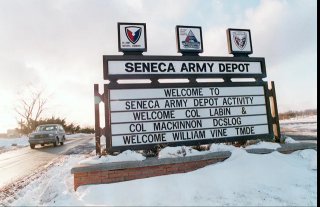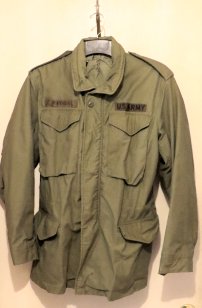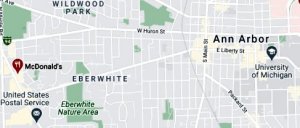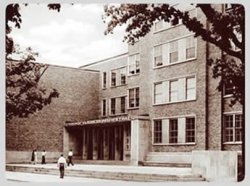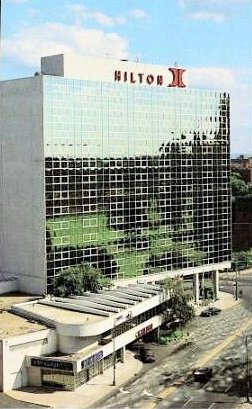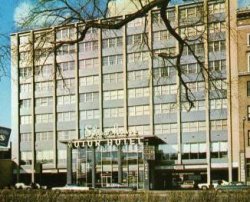SEAD to Ann Arbor to Kansas City to East Hartford. Continue reading
Although my last official day of active duty1 in the army was Monday, April 10, 1972, I had most of the last week off for out-processing—visits to the dentist and doctor, filling out forms, etc. The only thing that I remember vividly about April 10 was that there was still snow on the ground at Seneca Army Depot (SEAD), which made it ninety-two snow-covered days in a row since the day that I arrived.
My plan was to stop in Ann Arbor on my way back home. I missed U-M much more than I missed KC. By this time I had lost touch with all my high school friends, but I had exchanged letters with Bill Davey, who was finishing his first year at Law School. Some of the guys from Allen Rumsey House, notably Frank Bell, were probably still there, too. My plans were not very specific. I would stay in Ann Arbor until I ran out of money or stopped enjoying it.
I remember nothing about the trip to Ann Arbor. I probably took the reverse of the route that I had taken in January to get to the Rochester Airport. Then I flew to Detroit Metro, and I must have caught a bus to Ann Arbor. I would not have paid for a taxi, and Bill did not have a car. I think that I must have been wearing my uniform, but I don’t remember whether it was fatigues or “class A’s”. All my meager possessions were in my duffel bag. I am pretty sure that I did not bring a suitcase to SEAD. They let me keep all my Army clothes, including my field jacket, which I still have.
I must have walked from the bus stop to Bill Davey’s apartment. I slept on a couch or the floor there for the time that I was in town.
What did I do during the day? Well, mostly I walked around the campus and the surrounding area. I visited Allen Rumsey House, where I talked to Frank Bell and a few other guys. I walked down to the I-M building to see that AR’s record score for 1969-70 posted on the wall. I might have dropped by the Frieze Building to say hello to Dr. Colburn. I also have a vague recollection of attending some sort of hockey game with guys from AR. It wasn’t a varsity game. Maybe it was an intramural contest.
McDonald’s was the only place that I could fill my belly for $1, but there were none near the campus. I remember walking to the one on the west side of town at least twice. The no-nonsense hamburgers were twenty-five cents; I ate four of them on each visit.
I spent one afternoon at the placement office of U-M’s Business School. Someone there provided me with a list of actuarial contacts at quite a few large insurance companies.
After a few days in Ann Arbor I began to feel like an outsider. I decided to fly home and figure out my future in the comfortable environs there.
At home in Prairie Village I composed and typed letters to thirteen insurance companies. I explained my situation—just out of the Army with two actuarial exams. All thirteen responded. Ten companies said that they were not interested. Three in Hartford—Hartford Life, Aetna, and Travelers—wanted me to come in for an interview. They agreed to split the cost of my airfare and hotel expense. They put me up at the Hilton, which was within easy walking distance of all three.
I flew out by myself and took a taxi from Bradley to the Hilton. I do not remember too much about the interviews. I definitely talked with Jan Pollnow (a guy) at the Hartford. I remember that the atmosphere at the Hartford seemed much more open and relaxed. It reminded me of BMA. Even the buildings were similar towers.
At both the Aetna and Travelers there seemed to be rows and rows of clerks with mechanical calculators, real numbers factories. The Hartford had plenty of clerks also, but they seemed better placed, and there was more open area.
I think it was the Aetna that made me take the Actuarial Aptitude Test, which had two parts, verbal and math. I got all the questions right. The guy who escorted me around told me that I was the first person who ever did that. He said that plenty of applicants scored 100 percent on the math part, but no one else had ever gotten all the verbal questions right.
I received identical offers from all three companies at a starting salary of $13,000 per year, which seemed to me like a truly enormous amount of money. I had never made as much as $300 per month in the Army, and I did manage to save part of that. Another way to look at it was that my first year’s salary was much larger than the total amount of out-of-state tuition for four years at a top-rate university. Things were different in those days.
I accepted the offer from the Hartford and started making plans for my move to the Hartford area. The first order of business was to buy a car. My Army friend Al Williams had purchased a small Toyota in Albuquerque. I rode in it several times, and it seemed like a cheap, practical, and reliable car. My dad, who served in the Pacific in World War II, had a very low opinion of anything Japanese. He advised me to buy an American car, but there were none as cheap as Toyotas and Datsuns. Furthermore, most people who had not been strafed by the Japanese thirty years earlier thought that the Japanese cars were at least as good as what came out of Detroit in the seventies.
However, more and more 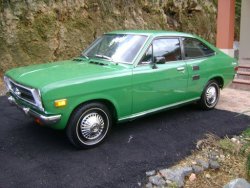 I looked at Datsuns and Toyotas, and I decided on a Datsun 1200 hatchback. I would be able to fold down the back seats and cart an enormous amount of my stuff from KC to Hartford. I picked a bright green one, which I called Greenie. I never had a problem finding that car in a parking lot.
I looked at Datsuns and Toyotas, and I decided on a Datsun 1200 hatchback. I would be able to fold down the back seats and cart an enormous amount of my stuff from KC to Hartford. I picked a bright green one, which I called Greenie. I never had a problem finding that car in a parking lot.
I tried to negotiated by myself by playing one dealer against another, but I am pretty sure that they had an agreement. They certainly were not desperate for the sale. At any rate, I did get to witness the Fargo scene in which the salesman pleaded my case with the sales manager. I think that he threw in an AM-FM radio and floor mats rather than reduce the price, which was around $2,000. My dad co-signed the loan.
The car was totally devoid of “girlie stuff”2: power steering, brakes, or windows, automatic transmission, etc. It did not have a manual choke, but I learned how to set the one on the motor. It was a nice car on the inside, but it was awful on snow and ice, had too little power too carry a big load over the hills of Pennsylvania, and, in its twilight years was very difficult to start in the winter. Still, I loved it. It was mine.
I did not leave for Hartford immediately. I bummed about for a little bit, and then my sister got mononucleosis, and I had to help my mother out. Jan Pollnow called to ask when I would be coming to work. I set a date in June. It may have even been July.
I loaded pretty much everything that I owned into Greenie, said goodbye to my family, and set off on a route similar to that of the big family vacation of my youth. Thank goodness for the Interstate Highway System that made my drive a lot easier than my dad’s. I left very early in the morning, but I did not try to make it all the way to Hartford. I never exceeded the speed limit.
 My recollection is that I stayed overnight in Hazleton, PA, but I don’t see how I could have driven that far by myself in one day. I can easily see myself leaving at the crack of dawn, but I would lose one hour by traveling east, and I definitely remember that I did not speed. To tell the truth, Greenie was uncomfortable at any speed over 60. Furthermore, I would not trust myself to drive very far after dark. Maybe I stopped at motels for two nights, once in some less memorable place in Indiana and once in Hazleton.
My recollection is that I stayed overnight in Hazleton, PA, but I don’t see how I could have driven that far by myself in one day. I can easily see myself leaving at the crack of dawn, but I would lose one hour by traveling east, and I definitely remember that I did not speed. To tell the truth, Greenie was uncomfortable at any speed over 60. Furthermore, I would not trust myself to drive very far after dark. Maybe I stopped at motels for two nights, once in some less memorable place in Indiana and once in Hazleton.
I had no credit card. I paid cash for everything. That, of course, was not unusual in the seventies.
I made a reservation for a couple of nights at the Shoreham Hotel, which at the time was located between the Hartford and the Aetna. I spent the evenings looking for an apartment. I used the want ads to locate two furnished apartments. I went to see both of them. One was very close to the Hartford. I was not crazy about the neighborhood. Instead I put down a deposit on one in East Hartford that actually had two addresses, 45 Olmstead and 23 Spring St. It looked like a motel that had been converted into apartments. It had a swimming pool in the back.
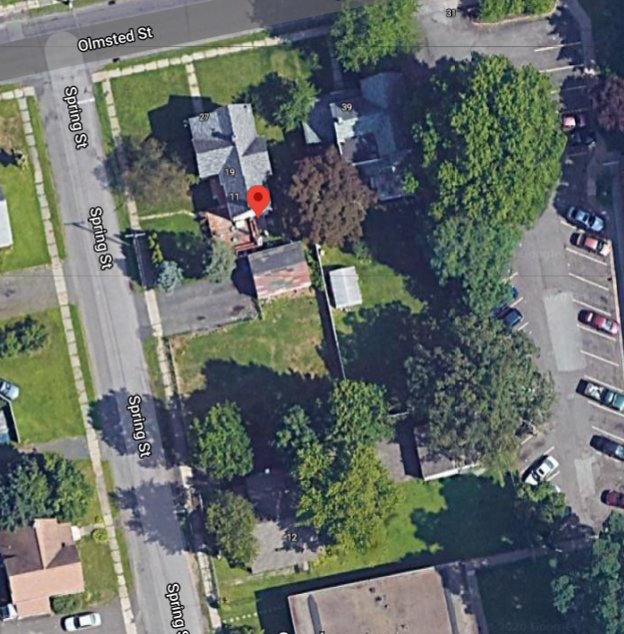 This is a satellite view in 2021 of the area that in 1972 was occupied by the apartment complex, which I think was called “The California Apartments” or something similar. The apartment building and the pool are completely gone, but the parking lot on the right is the one that was formerly used by residents of the apartment. I resided there until August or September of 1973.
This is a satellite view in 2021 of the area that in 1972 was occupied by the apartment complex, which I think was called “The California Apartments” or something similar. The apartment building and the pool are completely gone, but the parking lot on the right is the one that was formerly used by residents of the apartment. I resided there until August or September of 1973.
I unloaded all my stuff from Greenie. I had to walk upstairs, but in those days that was nothing to me. I had not brought anything that I could not carry by myself. I opened a bank account at Connecticut Bank and Trust (CBT—the bank that listens—and deposited the money that was in my KC account. Then I went shopping at the JM Fields department store on Silver Lane. I bought everything that I could think of that I would need—pots, pans, linen, pillows, towels, dishes, silverware, a cookbook, and all kinds of soaps and cleaning materials.
On the way back to the apartment I stopped by Kentucky Fried Chicken (not yet KFC) for supper. I am pretty sure that I ordered the eight-piece dinner (extra crispy), which in those days was two meals for me, and a large Coke.3 It was not as good as my mom’s chicken, but it was still tasty.
I knew almost no one at all in New England, but I had been in the same situation in 1966 at U-M. It felt good to be on my own, and I was primed for a new adventure.
1. Draftees were required to spend two years on active duty, two in the active reserve, and two in inactive reserve. When the active duty period for draftees was reduced in 1972, the active reserve period was concomitantly increased. So, I was in the active reserve until October 5, 1974. Since the Army had made it clear that it did not want the draftees, there was not much danger of being called up to active duty during that period. However, for three summers rather than two I was subject to being called to go to “summer camp” for two weeks of training.
2. I purloined this phrase from Rosemary Boxer on the British television show Rosemary and Thyme. She was disparaging the later Range Rover models for the inclusion of such frills.
3. Diet Coke was not introduced until 1982. The only low-calorie cola drink that the Colonel offered in the seventies was Tab, which had that horrible after-taste.

